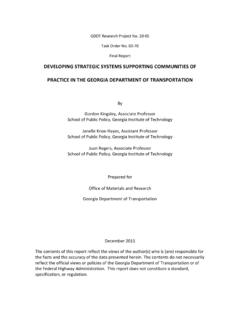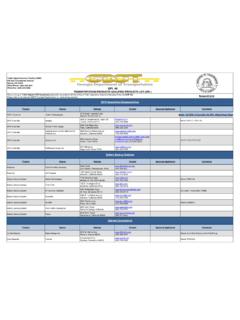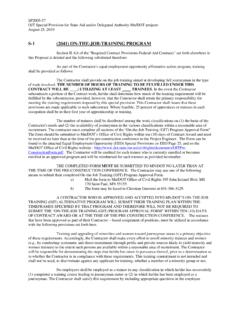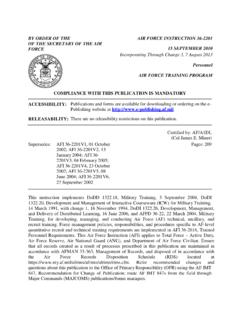Transcription of On-the-Job Training - Georgia Department of Transportation
1 Office of Equal Opportunity Employment On-the-Job Training O P E R A T O R C A R P E N T E R E S T I M A T O R F O R E M A N M E C H A N I C C O N C R E T E F I N I S H E R T R U C K D R I V E R A S P H A L T R A K E R Program Manual TABLE OF CONTENTS Program Overview Page A. Intent Who's Eligible? Training and Promotions (FHWA 1273) 1 B. Annual Goal Sett ing Methodology 2 C. OJT Program is Project Specific 2 D. Selection of Trainees Disadvantaged defined 2-3 Program Criteria A. Recognized Programs 3 B. Adding a new Trainee Classification 4 C. Good Faith Efforts 5 D. Contract Bid and Award 6 F.
2 Penalties and/ or Sanction On-the-Job Training after Contract Award (Steps to be taken) 6 A. Waivers 7 B. Program Approval Request (Step 1) 7 C. Trainee Approval (Step 2) 7 D. Trainee Monitoring (Step 3) 8 E. Trainee Program Completion (Step 4) 8 Other Miscellaneous Items A. Line Item Payments 9 B. Transportation Enhancement Projects 9 C. E-V erif y 9 D. Employee Lease Agr eements 9 E. Davis Bacon Act Contract Wage Rate Decisi on 9 Trainee Recruitment Resources A. Supportive Servi ces Goodwill 10 B. Georgi a Department of Labor 10 C. US Veterans Affairs 10 D. Approved Apprenticeship programs 10 Program Regulations A. Contract Provision FHWA 1273 11 B. Federal Regulation 12 C.
3 Standard Specification 158 13 Training Classification Outline A. Highway and Bridge Construction Trades 16-87 Assist in locating, qualifying, and increasing the skills of minorities and women. PROGRAM OVERVIEW The Georgia Department of Transportation s On-the-Job Training (OJT) Program policies are written in accordance with Federal Regulation , FHWA Office of Civil Rights Contractor Compliance Program guidelines, the Federal Contract Provision 1273, and GDOT Contract Specifications. Also considered in the program revision was the 2012 Contractors Annual EEO Report 1392, the September 2011 Government Accountability Office s Report to the House of Representatives, and the Georgia Secretary of State rule Suspension or Revocation of Certificate of Qualification or Certificate of Registration Intent of the program The primary objective of the OJT program is to train minorities, females and disadvantaged persons in highway construction classifications, by fostering equal Training opportunities for minorities.
4 Females and disadvantaged individuals on highway construction projects that receive federal funds in accordance with federal code section The OJT program is a recruitment and advancement program. The Contractor should review their current work force needs and consider the cost of New Hires or Upgrades in the overall cost of their bid. The Training program is not intended, and shall not be used, to discriminate against any applicant for Training , whether a member of a minority group or not. [23 CFR Part 230, Appendix B to Subpart A] Who is Eligible to participate in the OJT? Women, Minorities, and Disadvantaged individuals employed by a Contractor on a federally funded contract.
5 FHWA does not require that 100 percent of the trainees and apprentices on a project to be minority or women. However, Contractor Equal Employment Opportunity Affirmative Action Programs include On-the-Job Training aimed at fully qualifying trainees in the trade or job classification involved. Standard Specification 158 is in implementation of 23 USC 140(a). As a part of the Contractor s Equal Employment Opportunity Affirmative Action Program, the contractor must provide Training as specified in this specification. Employment Data, collected from the 2012 Construction Contractors Annual EEO Report, indicates minorities and females are under utilized in certain areas.
6 For this reason, contractors should demonstrate a systematic and direct recruitment effort to recruit females across all classifications, and minorities in areas of mechanics, welding, office engineers, foremen, and estimators. Good faith efforts must document the steps taken to recruit minorities and women for Training to comply with this Specification. (See definition of Good Faith Effort ). If reasonable recruitment efforts fail to produce a viable minority or female to fill a trainee position, the contractor may submit a Disadvantaged nonminority individual for approval. See definition of disadvantaged and reasonable efforts on page 3 of this document.
7 A denial into the program should not prevent a contractor from Training any employee outside of the program. Federal Contract Provision 1273- Training and Promotions. The contractor will assist in locating, qualifying, and increasing the skills of minorities and women who are applicants for employment or current employees. Such efforts should be aimed at developing full journey level status employees in the type of trade or job classification involved. 2 | Page Consistent with the contractor's work force requirements and as permissible under Federal and State regulations, the contractor shall make full use of Training programs, , apprenticeship, and On-the-Job Training programs for the geographical area of contract performance.
8 In the event a special provision for Training is provided under a contract, this subparagraph will be superseded as indicated in the special provision. The contractor will periodically review the Training and promotion potential of employees who are minorities and women and will encourage eligible employees to apply for such Training and promotion. Annual OJT Goal Process The Department is responsible for setting an annual Training goal and submitting the recommended Goal to FHWA for approval. The proposed goal is based upon a review of the Department s future project advertisements. If the Goal is not met, the Department must provide an explanation to FHWA of why the goal was not attained.
9 The following information is provided to further understand future Goals and how they are applied to projects: 0 Trainee for any Design Estimate on Resurfacing Projects, Projects less than $ 4,000, or project time estimates less than 1 year. 1 Trainee per $4,000, of Design Estimate on General Construction (Widening and Resurfacing) 1 Trainee per $4,000, of Design Estimate on Traffic Signal Projects/ATMS 1 Trainee per $4,000, of Design Estimate on Cable Barrier/Guardrail 1 Trainee per $5,000, of Design Estimate on Bridge Construction 1 Trainee per $5,000, of Design Estimate on Concrete Rehabilitation Projects Note: The goal is reviewed annually and adjusted. The Department may also adjust the formula during the year at the project level based on extenuating circumstances.
10 Previous annual goals were based on a different set of parameters; therefore, the above formula may not be applicable to a particular contract depending on the Let year. GDOT s OJT Program is Project Specific A project-specific OJT program assigns a trainee to a contractor for a specific Federal-aid project. Often times the trainee is unable to complete the OJT program on a specific project pending the number of hours assigned to the program. When the project is completed, the contractor has no obligation to keep the trainee. Therefore, the Department must ensure that contractors hire trainees early on in the project so that trainees are able to complete their Training program.



















